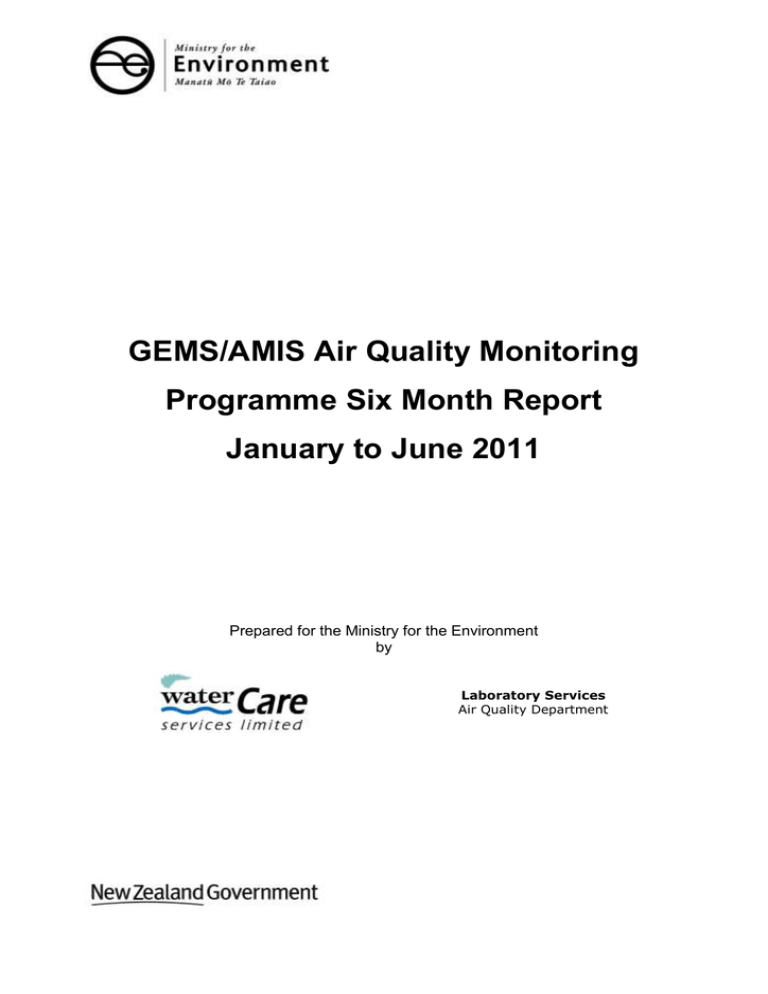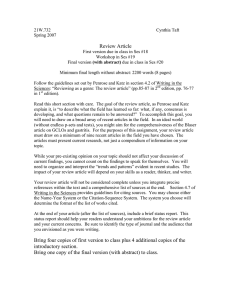GEMS/AMIS Air Quality Monitoring Programme Six Month Report January to June 2011
advertisement

GEMS/AMIS Air Quality Monitoring Programme Six Month Report January to June 2011 Prepared for the Ministry for the Environment by Laboratory Services Air Quality Department Disclaimer This report or document (the report) is given by Watercare Services Limited (Watercare) solely for the benefit of the Ministry for the Environment (MfE) as defined in the contract or terms and conditions between Watercare and MfE, and is strictly subject to the conditions laid out in that contract or terms and conditions. This report may not be reproduced, except in full. Neither Watercare nor any of its employees makes any warranty, express or implied, or assumes any legal liability or responsibility for use of the report or its contents by any other person or organisation. Watercare Services Ltd 52 Aintree Avenue Airport Oaks PO Box 107 028 Airport Oaks Auckland Ph 09 539 7600 Fax 09 539 7601 Prepared by: Reviewed by: Kathleen McLeod Senior Air Quality Technician and Key Technical Person Jonathan Taylor Air Quality Technician and Key Technical Person This report may be cited as: Ministry for the Environment. 2011. GEMS/AMIS Air Quality Monitoring Programme Six Month Report January to June 2011. Wellington: Ministry for the Environment. Published in December 2011 by the Ministry for the Environment Manatū Mō Te Taiao PO Box 10362, Wellington 6143, New Zealand ISBN: 978-0-478-37275-5 Publication number: ME 1086 © Crown copyright New Zealand 2011 This document is available on the Ministry for the Environment’s website: www.mfe.govt.nz Contents 1 Summary 1 2 Introduction 2 3 Air Pollutants Monitored 3 3 3 4 4 4 5 3.1 3.2 3.3 3.4 Nitrogen oxides Sulphur dioxide Volatile organic compounds Particulate matter 3.4.1 Particulate matter as PM10 3.4.2 Total suspended particulate 4 Ambient Air Quality Guidelines and Standards 6 5 Monitoring Sites 7 7 7 5.1 6 Methods 6.1 6.2 7 Site descriptions 5.1.1 MfE Gavin Street, Penrose, Auckland – Site AKL009 Quality assurance Analytical methods 6.2.1 Nitrogen oxides 6.2.2 Sulphur dioxide 6.2.3 Volatile organic compounds 6.2.4 Particulate matter as PM10 6.2.5 Total suspended particulate matter (TSP) Results and Discussion 7.1 7.2 7.3 7.4 7.5 7.6 Site performance and quality assurance Nitrogen oxides (NO2 and NO) Sulphur dioxide (SO2) Volatile organic compounds (VOC) Particulate matter (PM10) Total suspended particulates (TSP) GEMS/AMIS Air Quality Monitoring Programme Six Month Report January to June 2011 8 8 8 8 9 9 9 10 11 11 11 12 12 14 14 iii Figures Figure 1: Auckland TSP 7-day average January–June 2011 14 Figure 2: MfE Penrose NO2 1-hour fixed average January–June 2011 15 Figure 3: MfE Penrose NO2 1-hour fixed average 1997–June 2011 15 Figure 4: MfE Penrose NO2 24-hour fixed average January–June 2011 15 Figure 5: MfE Penrose NO2 24-hour fixed average 1997–June 2011 16 Figure 6: MfE Penrose NO2 and NO 1-hour fixed average January–June 2011 16 Figure 7: MfE Penrose NO2 and NO 24-hour fixed average January–June 2011 16 Figure 8: MfE Penrose NO 1-hour fixed average 1997–June 2011 17 Figure 9: MfE Penrose NO 24-hour fixed average 1997–June 2011 17 Figure 10: MfE Penrose SO2 1-hour fixed average January–June 2011 17 Figure 11: MfE Penrose SO2 1-hour fixed average 2003–June 2011 18 Figure 12: MfE Penrose SO2 24-hour fixed average January–June 2011 18 Figure 13: MfE Penrose SO2 24-hour fixed average 2003–June 2011 18 Figure 14: MfE Penrose PM10 24-hour fixed average January–June 2011 19 Figure 15: MfE Penrose PM10 24-hour fixed average 2003–June 2011 19 Tables Table 1: National environmental standards and guidelines Table 2: Percentage valid and capture data 11 Table 3: VOC results 13 iv GEMS/AMIS Air Quality Monitoring Programme Six Month Report January to June 2011 6 1 Summary This report contains six months of ambient air quality data from January to June 2011, measured from the Gavin Street, Penrose site in Auckland. The site is located within an industrial area and also represents vehicle emissions from State Highway One. The parameters formed part of New Zealand’s contribution to the Global Environmental Monitoring System (GEMS) run by the World Health Organization (WHO). The WHO stopped aggregating international air quality information from GEMS in 2006. The GEMS monitoring sites were established to measure key air pollutants associated with adverse effects on people’s health and wellbeing. In July 2011, air quality monitoring conducted by the Ministry for the Environment (MfE) under the GEMS programme in Auckland ended and was subsequently acquired by Auckland Council. Air quality monitoring conducted by MfE under the GEMS programme in Christchurch (Greers Road, Burnside and Coles Place, St Albans) ended in December 2010. MfE ambient air quality monitoring at the Gavin Street, Penrose site for the period of January to June 2011 showed that: all air pollutants monitored were below the national environmental standards (NES) for air quality as well as the ambient air quality guidelines (AAQG) for all averaging periods valid data for NO2 was 98% valid data for SO2 was 98% valid data for PM10 was 99% the maximum 1-hour NO2 concentration was 98.9 µg/m³ on 24 May 2011 10:00 the maximum 24-hour NO2 concentration was 60.0 µg/m³ on 30 June 2011 the maximum 1-hour SO2 concentration was 39.1 µg/m³ on 07 March 2011 16:00 the maximum 24-hour SO2 concentration was 15.9 µg/m³ on 29 June 2011 the average six month benzene concentration was 0.8 µg/m³ the maximum 24-hour PM10 concentration was 29 µg/m³ on 28 March 2011 the maximum 7 day TSP concentration was 39 µg/m³ on 06 April 2011. GEMS/AMIS Air Quality Monitoring Programme Six Month Report January to June 2011 1 2 Introduction This report presents the six months of ambient air quality data from January to June 2011 from the GEMS monitoring programme in Auckland, New Zealand. The monitoring was conducted by Watercare Services Limited (Watercare), on behalf of the Ministry for the Environment (MfE). Air pollutants arise from a number of different sources. The pollutants monitored at the Gavin Street, Penrose site include: particulate matter (PM10) – principally from domestic heating, vehicle emissions and industrial processes (as well as natural processes) nitrogen oxides (NO and NO2) – mostly from motor vehicle emissions sulphur dioxide (SO2) – from the burning of fossil fuels, particularly coal and oil total suspended particulates (TSP) – from various chemical and physical processes including all particulates less than 100 μm in aerodynamic diameter volatile organic compounds (VOCs) – organic chemicals, such as hydrocarbons, that are closely tied to vehicle emissions and many industrial processes. The monitoring has historically formed New Zealand’s contribution to the World Health Organization’s (WHO) Global Environmental Monitoring System / Air Pollution Programme (GEMS/AIR) which began in 19731. In 1996, WHO developed the Air Management Information System (AMIS) the successor to GEMS/AIR. The objective of AMIS is to transfer information on air pollutant concentrations and air quality management between countries. The WHO ceased aggregating international air quality information in 2006. The monitoring from the AMIS programme was used by MfE to support air quality monitoring and management in Auckland. The Gavin Street substation in Penrose is located in the industrial area of Penrose to the southeast of the city centre. Air quality monitoring has been conducted in Penrose since 1964 (TSP and Pb) and all MfE monitoring at this site was taken over by Auckland Council in July 2011. Air quality monitoring conducted by MfE under the GEMS programme in Christchurch (Greers Road, Burnside and Coles Place, St Albans) ended in December 2010. All data in this report has been validated. Quality assurance checks have been carried out to ensure that invalid and calibration data is not reported. This report presents: a description of the parameters monitored an overview of the relevant guideline and standards a description of the monitoring site the methods undertaken a summary of site performance a graphical and statistical presentations of results. 1 2 Schwela DH. 1999. Public Health and the air management information system (AMIS). Epidemiology, 10(5), 647-655. GEMS/AMIS Air Quality Monitoring Programme Six Month Report January to June 2011 3 Air Pollutants Monitored 3.1 Nitrogen oxides Nitrogen oxides incorporate several substances that exist in the atmosphere and are collectively referred to as NOx. The two main oxides are nitrogen dioxide (NO2) and nitric oxide (NO). NOx are formed in most combustion processes by oxidation of the nitrogen present in the atmosphere. NO is the predominant primary product but this can then be oxidised to NO2 in ambient air. Emissions from motor vehicles are the major source of NO2 in most parts of the country although power stations and other large combustion units may be significant localised sources as well2. NOx is also an important air pollutant because of its role in photochemical smog. NO2 is a reddish brown, pungent toxic gas and has synergistic health effects with other pollutants such as sulphur dioxide and particulate matter. The main health effects of the NOx are due to NO2, which is a respiratory irritant. Sensitivity can increase for children, people suffering from asthma and other respiratory conditions. 3.2 Sulphur dioxide Sulphur dioxide (SO2) is an acidic gas with a pungent odour which is mainly produced by the burning of fossil fuels. The gas is corrosive and can cause damage to buildings and other materials. It can also have significant effects on the human respiratory system. Inhalation of high ambient concentrations of sulphur dioxide can cause stimulation of the nerves in the air passages, resulting in a reflex cough, irritation and chest tightness. In addition, SO2 can also cause narrowing of the air passages, particularly in people suffering from asthma and chronic lung disease. These people frequently have narrowed airways and any further restriction will have a more significant effect compared to people with uncompromised respiratory systems. 2 Ministry for the Environment. 2003. Emission Inventories for CO, NOx, SO2, ozone, benzene and benzo(a)pyrene in New Zealand. http://www.mfe.govt.nz/publications/air/air-quality-tech-report-44nov03/index.html. GEMS/AMIS Air Quality Monitoring Programme Six Month Report January to June 2011 3 3.3 Volatile organic compounds Volatile organic compounds (VOCs) are chemicals that easily evaporate at room temperature. The term ‘organic’ indicates that the compounds contain carbon. VOCs include a wide range of carbon-based molecules, such as some aldehydes, ketones and hydrocarbons. The Ministry for the Environment has compiled a list of priority contaminants, based on a review of international literature. The priority list includes the VOCs benzene and 1,3-butadiene and provides ambient air quality guidelines for these contaminants3. VOCs can produce neurological impairment, and benzene is well established as a carcinogen. 3.4 Particulate matter Particulate matter (PM) can be a significant air pollutant that is associated with a variety of health and environmental effects. Sources of particulates vary widely from location to location reflecting the wide range of emission sources that contribute to particulate concentrations in New Zealand. Typical sources of various particulate sizes can include: Fine particulates (less than 2.5 μm) emitted as a result of incomplete fuel combustion from road vehicles, power generation, industrial processes and domestic heating appliances. Fine particulates also form by chemical reactions in the atmosphere. These comprise largely of sulfates and nitrates. Coarse particulates (between 2.5 and 10 μm) that arise from a wide range of sources, including re-suspended dust from road vehicles, construction works, mineral extraction processes, wind-blown dust and soils, sea salt and biological particulates such as pollen and fungal spores. Particulate matter refers to numerous substances that exist in the atmosphere. It is a somewhat complex pollutant, encompassing a wide range of chemically and physically diverse substances. Particulate matter includes all solid and liquid aerosols that exist in ambient conditions. As part of the GEMS/AMIS programme two particle size fractions were monitored: particulate matter less than 10 μm (PM10) total suspended particulates (TSP). 3.4.1 Particulate matter as PM10 The main effect of PM10 is on human health as PM10 can be inhaled into the respiratory system. PM10 can become deposited in the trachea bronchial region, where asthma attacks are triggered. 3 4 Ministry for the Environment. 2002. Ambient Air Quality guidelines – 2002 Update. Wellington: Ministry for the Environment. GEMS/AMIS Air Quality Monitoring Programme Six Month Report January to June 2011 3.4.2 Total suspended particulate TSP consists of all particles which range in size up to 100 µm in diameter. TSP is sufficiently small enough to be inhaled; however, the larger particles (10 – 100 µm) are readily filtered out in the nasal cavity. TSP has an effect on both the aesthetic and health qualities of ambient air. GEMS/AMIS Air Quality Monitoring Programme Six Month Report January to June 2011 5 4 Ambient Air Quality Guidelines and Standards In October 2004, the Ministry for the Environment introduced the National Environmental Standards (NES) for Air Quality. The NES includes five standards for ambient (outdoor) air quality. Three of these standards and some New Zealand guidelines are described in Table 1 below. The carbon monoxide and ozone standards were not included as they are not measured at the site discussed in this report. The criteria used for TSP, 60 µg/m3 (seven-day average), was previously used by the Ministry of Health (MoH). This has been superseded by the ambient air quality guidelines but is still useful for analysing the results of the monitoring data. National environmental standards and guidelines4 Table 1: Air pollutant Nitrogen dioxide Sulphur dioxide Averaging period Ministry for the Environment Ambient Air Quality Guidelines 2002 and other 24-hour average 100 µg/m3 1-hour average 200 µg/m3 National Environmental Standards 2004 National Environmental Standards permissible excess 200 µg/m3 9 hours in a 12-month period 350 µg/m3 9 hours in a 12-month period 570 µg/m3 Not to be exceeded at any time 50 µg/m3 One 24-hour period in a 12-month period 3 24-hour average 120 µg/m 1-hour average 350 µg/m3 1-hour average Benzene – Year 2002 Annual average 10 µg/m3 – Year 2010 Annual average 3.6 µg/m3 1,3-Butadiene Annual average 2.4 µg/m3 Fine particulate (PM10) Annual average 20 µg/m3 24-hour average 50 µg/m3 Total suspended particulate (TSP) 7-day average 60 µg/m3 (MoH) 4 6 Source: http://www.mfe.govt.nz/laws/standards/air-quality-standards.html. GEMS/AMIS Air Quality Monitoring Programme Six Month Report January to June 2011 5 Monitoring Sites 5.1 Site descriptions A brief description of the GEMS/AMIS air quality monitoring site is given below. 5.1.1 MfE Gavin Street, Penrose, Auckland – Site AKL009 Site name MfE Gavin Street, Penrose Site ID AKL009 Address Transpower, Gavin Street, Penrose, Auckland Site class Industrial – dense Traffic – peak Description This site is operated by Watercare and is located within the grounds of the Transpower NZ Ltd electrical substation on Gavin Street, Penrose. It is representative of road, vehicle and industrial emissions in the Penrose area which lies to the southeast of Auckland City. The site is approximately 120 metres northeast of the Southern Motorway. There are residential properties immediately to the northeast of the site. During 2003, parallel monitoring was undertaken between this site and the neighbouring ACI site on Great South Road, in Penrose with a view to consolidating all monitoring at the Gavin Street site early in 2004. Pollutants monitored by MfE Meteorological parameters monitored Location map CO NO2 SO2 VOCs N Y Y Y PM10 TSP Lead Y Y Y Wind speed Wind direction Relative humidity Y Y Y Temperature (6m) Temperature (10m) Temperature (1.5m) Y N N Photograph MfE Gavin Street, Penrose GEMS/AMIS Air Quality Monitoring Programme Six Month Report January to June 2011 7 6 Methods 6.1 Quality assurance All monitoring services were undertaken by Watercare in accordance with the MfE ‘Good Practice Guide for Air Quality Monitoring and Data Management’ (or GPG) and wherever applicable the appropriate Australian/New Zealand and US EPA monitoring methods. Watercare is accredited by International Accreditation New Zealand (IANZ) for the following methods: AS 3580.5.1-1993 ‘Method 5.1: Determination of oxides of nitrogen – chemiluminescence method’ AS 3580.4.1-2008 ‘Method 4.1: Determination of sulphur dioxide – direct reading instrumental method’ AS/NZS 3580.9.3-2003 ‘Method 9.3: Determination of ambient particulates (gravimetric method) – TSP high volume sampling’ AS/NZS 3580.9.6-2003 ‘Method 9.6: Determination of ambient particulates (gravimetric method) – PM10 high volume sampling’ AS 3580.9.11 – 2008 ‘Method 9.11: Determination of suspended particulate matter – PM10 beta attenuation monitors’. As part of the GEMS/AMIS programme, Watercare provides the following monitoring services: 1. Instrument operation, calibration and maintenance. This includes the use of automatic daily calibration systems for all continuous ambient gas monitors ensuring that the requirements of the relevant Australian Standards for weekly calibration of continuous analysers were met. 2. Site maintenance as well as commissioning new sites and decommissioning old sites, when necessary. 3. Data logging, polling, checking, re-scaling, validation, reviewing and reporting. This encompasses the entire data quality assurance process ensuring that the final data set reported is fit for the purpose of the GEMS/AMIS programme. 6.2 Analytical methods 6.2.1 Nitrogen oxides Measurements were made in accordance with AS 3580.5.1-1993 ‘Determination of Oxides of Nitrogen – Chemiluminescence Method’. The performance of the instrument is checked using an automatic calibration system ensuring compliance with the method which requires instrumentation to be calibrated on a weekly basis. 8 GEMS/AMIS Air Quality Monitoring Programme Six Month Report January to June 2011 The instruments used were chemiluminescence gas analysers which continuously measure NO x. This allows data to be analysed and reported over a variety of average periods, including 10 minute, 24 hour and one year. 6.2.2 Sulphur dioxide Measurements were made in accordance with AS 3580.4.1-2008 ‘Determination of Sulphur Dioxide – Direct Reading Instrumental Method’. The performance of the instrument is checked using an automatic calibration system ensuring compliance with the method which requires instrumentation to be calibrated on a weekly basis. The instruments used were UV fluorescence gas analysers which continuously measure SO2. This allows data to be analysed and reported over a variety of average periods, including 10 minute, 24 hour and one year. 6.2.3 Volatile organic compounds VOCs were measured using passive organic vapour monitor badges, which were exposed for three-month periods (January–March, April–June, July–September and October–December). The VOCs diffuse on to the badges, which were coated with activated carbon. Following exposure, the samples were forwarded to AsureQuality who extract the VOCs using carbon disulfide and analyse them using gas chromatography-mass spectrometry (GC-MS). AsureQuality is IANZ accredited for analysing VOCs by GC-MS using National Institute for Occupational Safety and Health (NIOSH) Method 1500. The subsequent results were calculated in accordance with the manufacturer’s instructions (3M Technical Data Bulletin 1028) allowing results to be converted to standard temperature (0 °C) and pressure (1 atm). Note: Samples of 1,3-butadiene are unstable when held above -4.41 C with significant reverse desorption occurring. Due to the potential for error over a three-month exposure period, 1,3-butadiene has not been analysed and reported. Alternative methods of measuring 1,3-butadiene are OSHA Method 56 and NIOSH Method 1024. Both of these involve the use of solid sorbent coconut charcoal tubes. 6.2.4 Particulate matter as PM10 Measurements were made in accordance with AS 3580.9.11–2008 ‘Determination of suspended particulate matter – PM10 beta attenuation monitors’ (BAM). The instrument was fitted with a size-selective PM10 head with an inlet temperature of 40 °C. The BAM continuously measures the intensity of beta particles passing through a filter tape. This allows PM10 data to be analysed and reported over a variety of average periods, including 10 minute, 24 hour and one year. GEMS/AMIS Air Quality Monitoring Programme Six Month Report January to June 2011 9 6.2.5 Total suspended particulate matter (TSP) TSP monitoring was in accordance with Watercare’s Air Quality Group Test Method T101. The method was based on Australian Standard 2724.2 – 1987 and British Standard 1747 and was developed by the Ministry of Health (MoH). It is a gravimetric method of measuring particulates and is modelled on the system for high volume sampling as described in AS/NZS 3580.9.3-2003. The equipment used to collect TSP involved ambient air being pulled through a 55 mm glass fibre filter by a vacuum pump. A gas meter is attached and is used to measure the air volume (m³) drawn through the filter. The filter is held in a cassette and is covered with a rain shelter at 3.5 m above ground. Preweighed filters were collected and sampled on a weekly or 7 day cycle every Thursday. This method is different to that recommended in the Ministry for the Environment’s ‘Good Practice Guide for Air Quality Monitoring and Data Management 2010’. The method has been used to measure TSP since 1964 and the results will vary when compared to more modern techniques. 10 GEMS/AMIS Air Quality Monitoring Programme Six Month Report January to June 2011 7 Results and Discussion 7.1 Site performance and quality assurance Monthly site performance and any explanations are shown in Table 2, based on 10 minute averages for continuously monitored data. Per cent of valid data (V) is defined as the per cent of valid data following quality assurance adjustments. Per cent of captured data (C) is the per cent of valid data excluding calibration and maintenance. The 2000 MfE Good Practice Guide for Air Quality Monitoring and Data Management suggests that it is difficult to reach anything close to 100% valid data for long-term monitoring. As such site performance has been evaluated against a target of 95% for capture data and 75% for valid data. The site performance during the monitoring period was excellent. Valid data was greater than 97% and captured data was greater than 99%. Table 2: Analyte Percentage valid and capture data Site Percentage valid data (V) and percentage data capture (C) Jan V Feb C V Mar C Apr May Jun V C V C V C V Total C V C NO2 Penrose 98.5 100.0 98.4 100.0 97.6 99.6 98.2 99.9 98.1 99.6 98.2 100.0 98.2 99.8 SO2 Penrose 97.7 99.9 97.6 99.6 97.6 99.5 98.0 99.9 97.9 99.8 97.7 99.8 97.8 99.8 VOC Penrose 100 100 100 100 100 100 100 100 100 100 100 100 100 100 PM10 Penrose 98.3 99.5 99.2 99.9 98.7 99.3 98.5 99.4 98.9 99.5 99.1 99.8 98.8 99.6 TSP Penrose 100 100 100 100 100 100 100 100 100 100 100 100 100 100 7.2 Nitrogen oxides (NO2 and NO) Nitrogen oxides were monitored at Gavin Street, Penrose with 1-hour and 24-hour averages calculated from 10-minute averages recorded by the instrument. Summary statistics for NO2 and their dates are described below. Site Maximum 1-hour average (µg/m3) 99.9 percentile 1-hour average (µg/m3) Maximum 24-hour average (µg/m3) 99.5 percentile 24-hour average (µg/m3) Gavin Street, Penrose 98.9 (24 May 10:00) 85.0 60.0 (30 Jun) 56.5 There were no exceedences of the NO2 ambient air quality national environmental 1-hour standard (200 µg/m3) or the 24-hour guideline (100 µg/m3) from January to June 2011. The NOx results for Penrose are shown in Figures 2 to 9. GEMS/AMIS Air Quality Monitoring Programme Six Month Report January to June 2011 11 7.3 Sulphur dioxide (SO2) Sulphur dioxide was monitored at Gavin Street, Penrose with 1-hour and 24-hour averages calculated from 10-minute averages recorded by the instrument. Summary statistics for SO2 and their dates are described below. Site Gavin Street, Penrose Maximum 1-hour average (µg/m3) 99.9 percentile 1-hour average (µg/m3) Maximum 24-hour average (µg/m3) 99.5 percentile 24-hour average (µg/m3) 39.1 (07 Mar 16:00) 31.5 15.9 (29 Jun) 13.8 There were no exceedences of the SO2 ambient air quality national environmental 1-hour standard (350 µg/m3) or the 24-hour guideline (120 µg/m3) from January to June 2011. The SO2 results for Penrose are shown in Figures 10 to 13. 7.4 Volatile organic compounds (VOC) VOCs were monitored at Gavin Street, Penrose with passive sampler badges exposed over a 3-month period. The 6-month average for benzene from January to June 2011 is described below. Six-month average for benzene (µg/m3) Site Gavin Street, Penrose 0.8 The benzene 2002 guideline was 10 µg/m3 as an annual average, with an annual average of 3.6 µg/m3 to be achieved by 2010. The benzene 6-month average was less than the annual average guideline (3.6 µg/m3). Results from January to June 2011 are shown in Table 3. 12 GEMS/AMIS Air Quality Monitoring Programme Six Month Report January to June 2011 Table 3: VOC results Analyte January–March 2011 April–June 2011 Limit of detection (µg/m3) Results (µg/m3) Limit of detection (µg/m3) Results (µg/m3) ethanol 4.0 ND 3.6 ND isopropyl alcohol 2.3 ND 2.0 ND acetone 2.4 ND 2.1 ND pentane 2.5 5.0 2.2 5.1 dichloromethane 2.6 ND 2.3 ND butan-2-one 2.6 ND 2.3 ND hexane 0.5 0.6 0.5 1.0 ethyl acetate 0.5 ND 0.5 ND trichloromethane 0.5 ND 0.5 ND 1,1,1-trichloroethane 0.6 ND 0.5 ND n-butanol 2.7 ND 2.4 ND benzene 0.3 0.6 0.2 1.0 2-methylhexane 0.6 ND 0.5 ND 2,3-dimethylpentane 0.6 ND 0.5 ND 3-methylhexane 0.6 ND 0.5 0.6 heptane 0.6 ND 0.5 ND trichloroethene 0.6 ND 0.5 ND propyl acetate 0.6 ND 0.5 ND methylcyclohexane 0.6 ND 0.5 ND 4-methylpentan-2-one 0.6 ND 0.5 ND toluene 0.3 5.0 0.2 7.1 octane 0.6 ND 0.6 ND tetrachloroethene 0.6 ND 0.5 ND butyl acetate 0.5 ND 0.5 0.5 ethylbenzene 0.3 0.6 0.3 1.0 m+p-xylene 0.3 2.2 0.3 3.5 styrene 0.7 ND 0.6 ND o-xylene 0.3 0.8 0.3 1.3 nonane 0.6 ND 0.6 ND alpha pinene 0.8 ND 0.7 ND propylbenzene 0.7 ND 0.6 ND 1,3,5-trimethylbenzene 0.6 ND 0.6 ND beta pinene 0.8 ND 0.7 ND decane 0.7 ND 0.6 ND 1,2,4-trimethylbenzene 0.7 0.7 0.6 1.1 limonene 0.8 ND 0.7 ND undecane 0.8 ND 0.7 ND dodecane 0.7 ND 0.7 ND tetradecane 0.8 ND 0.7 ND Target VOCs ND = Not detected. GEMS/AMIS Air Quality Monitoring Programme Six Month Report January to June 2011 13 7.5 Particulate matter (PM10) PM10 was monitored at Gavin Street, Penrose with 24-hour averages calculated from 10-minute averages recorded by the instrument. Summary statistics for PM10 and the maximum date are described below. Site Maximum 24-hour average (µg/m3) 99.5 percentile 24-hour average (µg/m3) 29 (28 Mar) 27 Gavin Street, Penrose There were no exceedences of the PM10 ambient air quality national environmental 24-hour standard (50 µg/m3) from January to June 2011. The PM10 results for Penrose are shown in Figures 14 and 15. 7.6 Total suspended particulates (TSP) TSP was measured as a 7-day average at Gavin Street, Penrose. The maximum result and date (7-day ending period) are described below. Site Maximum 7-day average (µg/m3) Gavin Street, Penrose 39 (06 Apr) There were no exceedences of the TSP ambient air quality MoH 7-day guideline (60 µg/m3). The TSP results for Penrose are shown in Figure 1. Figure 1: Auckland TSP 7-day average January–June 2011 100 90 Gavin Street, Penrose 80 70 TSP µg/m³ MoH Guideline = 60µg/m³ 60 50 40 30 20 10 0 Jan-11 Feb-11 Mar-11 Apr-11 May-11 Jun-11 Date 14 GEMS/AMIS Air Quality Monitoring Programme Six Month Report January to June 2011 Figure 2: MfE Penrose NO2 1-hour fixed average January–June 2011 NES = 200 µg/m³ Figure 3: MfE Penrose NO2 1-hour fixed average 1997–June 2011 NES = 200 µg/m³ Figure 4: MfE Penrose NO2 24-hour fixed average January–June 2011 AAQG = 100 µg/m³ GEMS/AMIS Air Quality Monitoring Programme Six Month Report January to June 2011 15 Figure 5: MfE Penrose NO2 24-hour fixed average 1997–June 2011 AAQG = 100 µg/m³ Figure 6: MfE Penrose NO2 and NO 1-hour fixed average January–June 2011 Figure 7: MfE Penrose NO2 and NO 24-hour fixed average January–June 2011 16 GEMS/AMIS Air Quality Monitoring Programme Six Month Report January to June 2011 Figure 8: MfE Penrose NO 1-hour fixed average 1997–June 2011 Figure 9: MfE Penrose NO 24-hour fixed average 1997–June 2011 Figure 10: MfE Penrose SO2 1-hour fixed average January–June 2011 NES = 350 µg/m³ GEMS/AMIS Air Quality Monitoring Programme Six Month Report January to June 2011 17 Figure 11: MfE Penrose SO2 1-hour fixed average 2003–June 2011 NES = 350 µg/m³ Figure 12: MfE Penrose SO2 24-hour fixed average January–June 2011 AAQG = 120 µg/m³ Figure 13: MfE Penrose SO2 24-hour fixed average 2003–June 2011 AAQG = 120 µg/m³ 18 GEMS/AMIS Air Quality Monitoring Programme Six Month Report January to June 2011 Figure 14: MfE Penrose PM10 24-hour fixed average January–June 2011 NES = 50 µg/m³ Figure 15: MfE Penrose PM10 24-hour fixed average 2003–June 2011 NES = 50 µg/m³ GEMS/AMIS Air Quality Monitoring Programme Six Month Report January to June 2011 19



